The Brahma-Daitya

Towards the end of 1869, Srila Bhaktivinoda Thakur transferred to Champaran. While there, the Thakur observed many persons worshiping a powerful brahma-daitya, who was living in a Banyan tree. This ghost had the power to influence people’s minds, and a local court judge, who was under his spell, repeatedly delivered court judgments which favoured some bandits who were making offerings to gain the favour of the ghost. (A brahma-daitya is a ghost who was formerly a brahmana, but due to his sinful activities he becomes a very powerful ghost who can create a lot of mischief.)
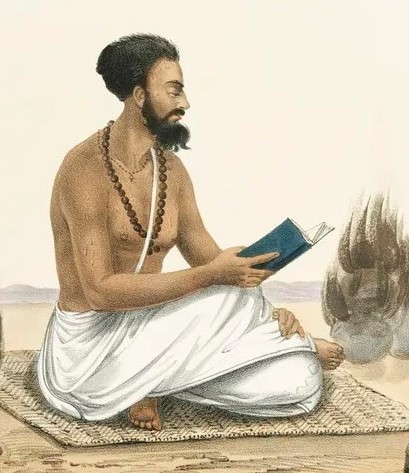
One day a pandit approached the Thakur to beg for alms, and the Thakur engaged him to recite the Srimad Bhagavatam beneath the tree where the ghost resided. After one month, when the reading was completed, the tree fell to the ground and the brahma-daitya left. The bandits were irritated as they had lost the ghost’s protection, but many townspeople took inspiration from this incident and took up the message of Srimad Bhagavatam.
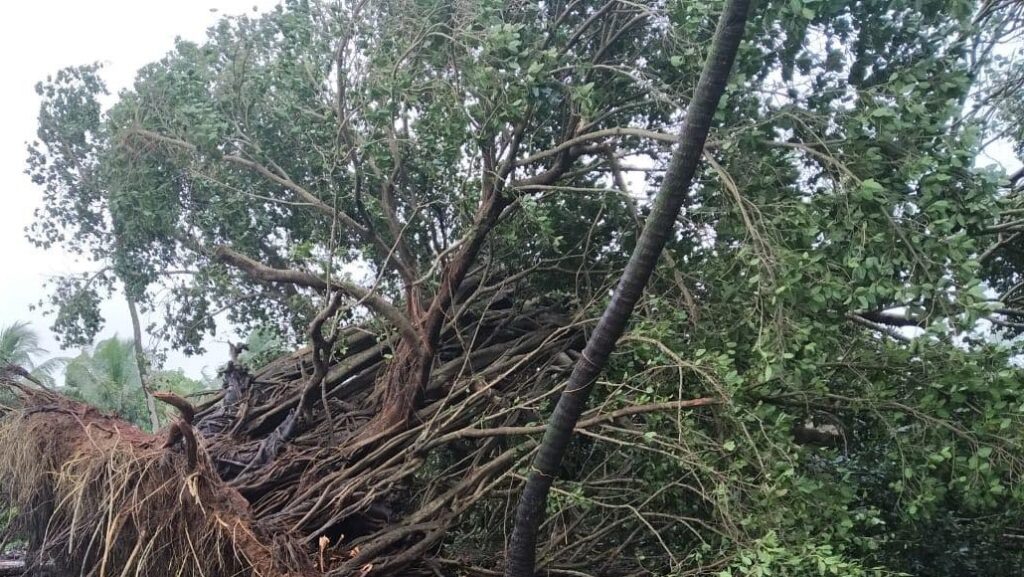
[Excerpts from “The Seventh Goswami” by Rupa Vilas Das and the Autobiography of Bhaktivinoda Thakur]
Srila Bhaktivedanta Swami on Ghosts
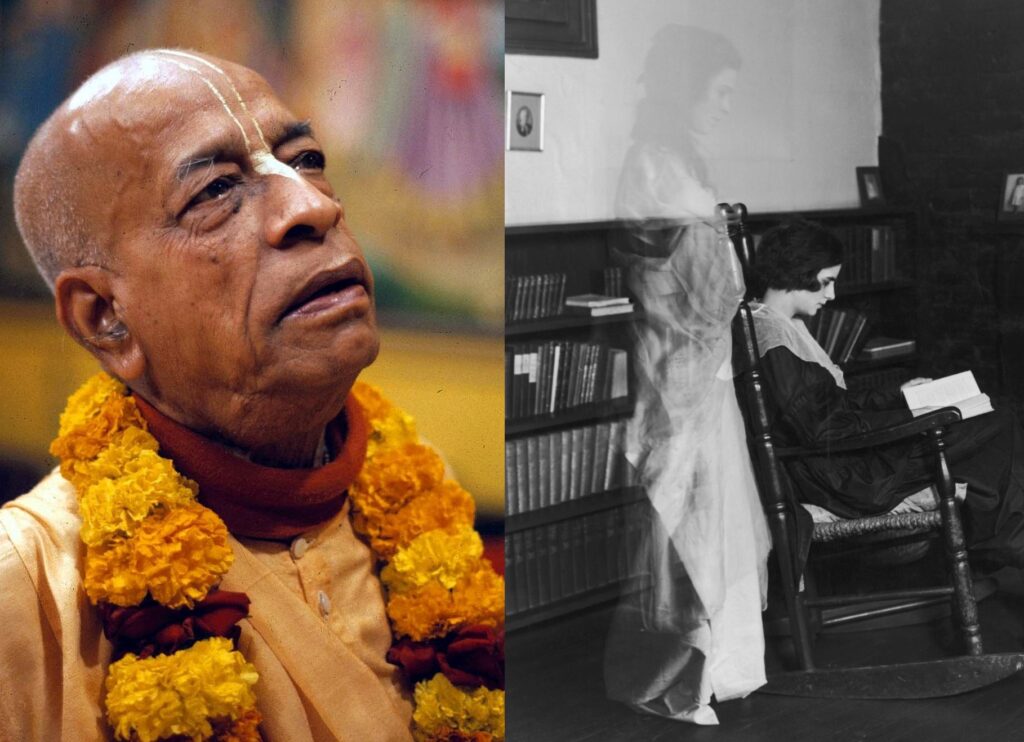
Those who are very sinful and attached to their family, house, village or country do not receive a gross body made of material elements but remain in a subtle body, composed of mind, ego and intelligence. Those who live in such subtle bodies are called ghosts. This ghostly position is very painful because a ghost has intelligence, mind and ego and wants to enjoy material life, but because he doesn’t have a gross material body, he can only create disturbances for want of material satisfaction.
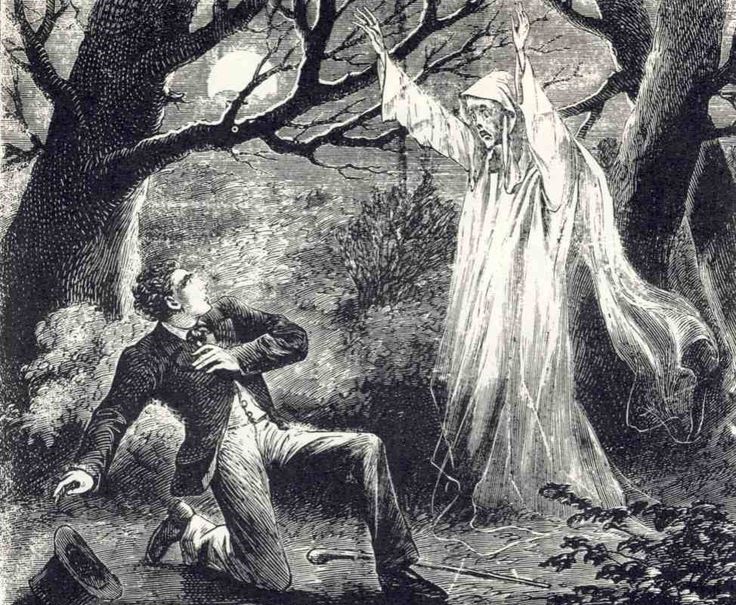
It is the duty of family members, especially the son, to offer oblations to the demigod Aryama or to Lord Vishnu. From time immemorial in India the son of a dead man goes to Gaya and, at a Vishnu temple there, offers oblations for the benefit of his ghostly father.
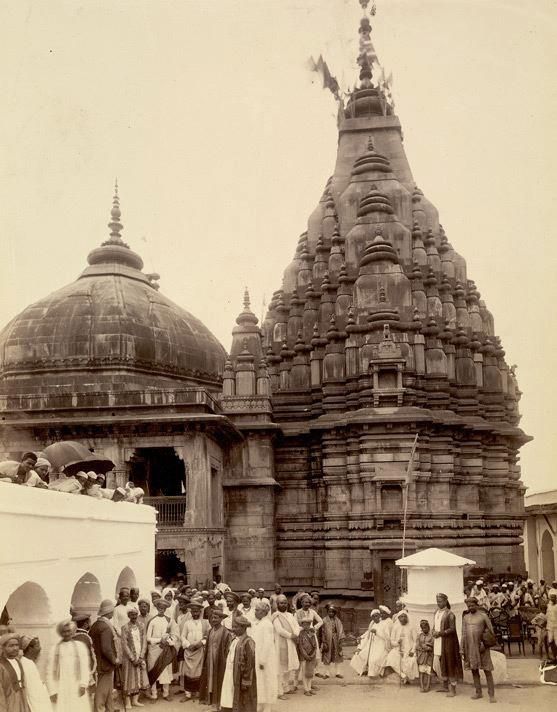
The Vishnupad Temple at Gaya
It is not that everyone’s father becomes a ghost, but the oblations of pinda are offered to the lotus feet of Lord Vishnu so that if a family member happens to become a ghost, he will be favored with a gross body. However, if one is habituated to taking the prasada of Lord Vishnu [or Krishna] there is no chance of his becoming a ghost or anything lower than a human being. In Vedic civilization there is a performance called sraddha by which food is offered with faith and devotion. If one offers oblations with faith and devotion – either to the lotus feet of Lord Vishnu or to His representative in Pitrloka, Aryama – one’s forefathers will attain material bodies to enjoy whatever material enjoyment is due them. In other words, they do not have to become ghosts.
[Srimad Bhagavatam 4:18:18 purport]
As a young man, Lord Chaitanya travelled to Gaya to offer oblations of pinda for His departed father. It was here that He met his spiritual master, Isvara Puri.
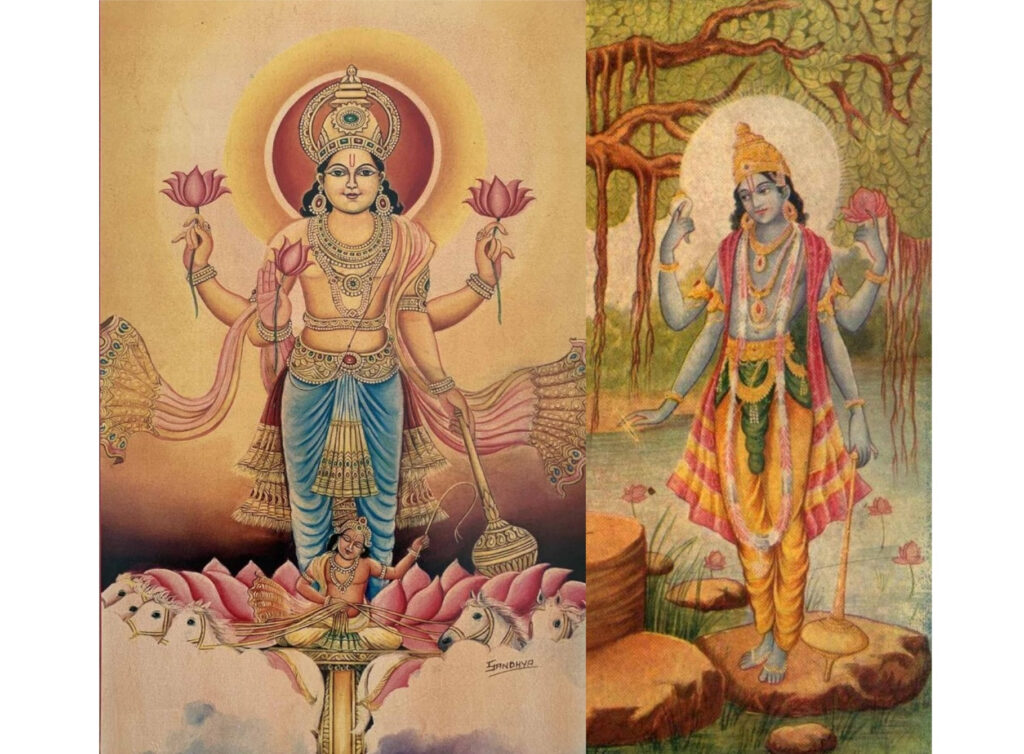
Aryama and Lord Vishnu
The Chastisemment of Bisakisena
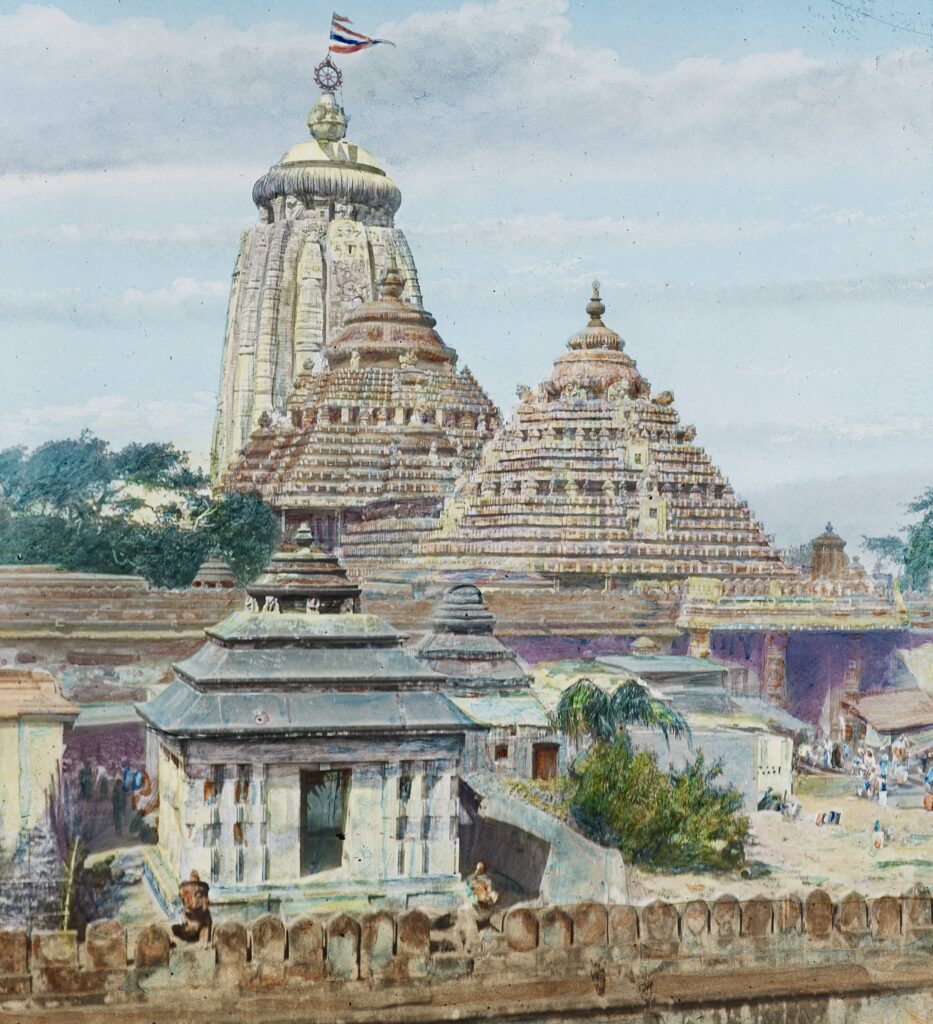
Jagannath Temple at Puri
In 1871, Bhaktivinoda Thakur went from Camparana to Puri in the state of Orissa, which engladdened his heart. He held the post of Court Magistrate, and one of his duties was to manage the Jagannath Temple. Orissa was formerly known as Utkala. This state originally belonged to Dhruva Maharaja. He ruled there, and after he left his body he inherited the Pole Star, now called Dhruvaloka. His son’s name was Maharaja Utkala.
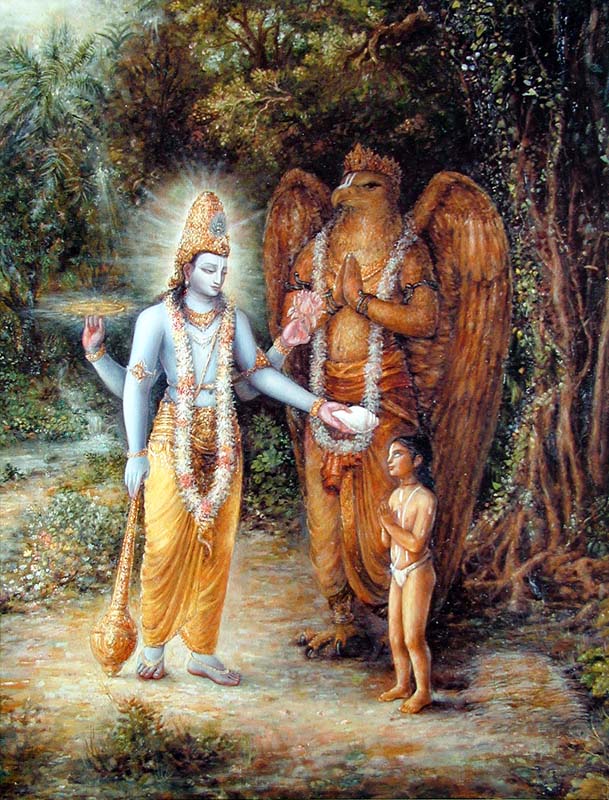
Lord Vishnu appears to Dhruva Maharaj
Near Bhubaneswar, the capital of Orissa, in the town of Kamanala, there lived a mystic yogi named Bisakisena. In the first year of Bhaktivinoda Thakur’s stay in Puri (1871) the Thakur was given the task of quelling the disturbance caused by this mystic yogi, who claimed to be an incarnation of Maha-Vishnu.
Bisakisena belonged to a sect called the Atibari-sampradaya, started by a certain Jagannath das, who had been ordered by Lord Chaitanya to follow Haridas Thakur. At some point Jagannath rejected Lord Chaitanya’s instructions and took shelter of Mayavada (impersonalist) philosophy. Lord Chaitanya rejected him, and for this reason he was called “Atibari” (“one who has been rejected.”)
The Atibari-sampradaya was one of the “apa-sampradayas,” “apa” meaning “outside” the bonafide Vaisnava disciplic successions – deviant sampradayas that do not follow the conclusions of scripture. The Atibari group was secretive in its practices, and the Thakur states:
This group has many forged books wherein it is written that Chaitanya will appear again. Among them, there are some evil-minded people who attempt to imitate Chaitanya or Brahma, and some who imitate Baladeva or Krishna. One person known as Bisakisena, a scoundrel who had developed a little yogic power, was thought to be Maha-Vishnu Himself.
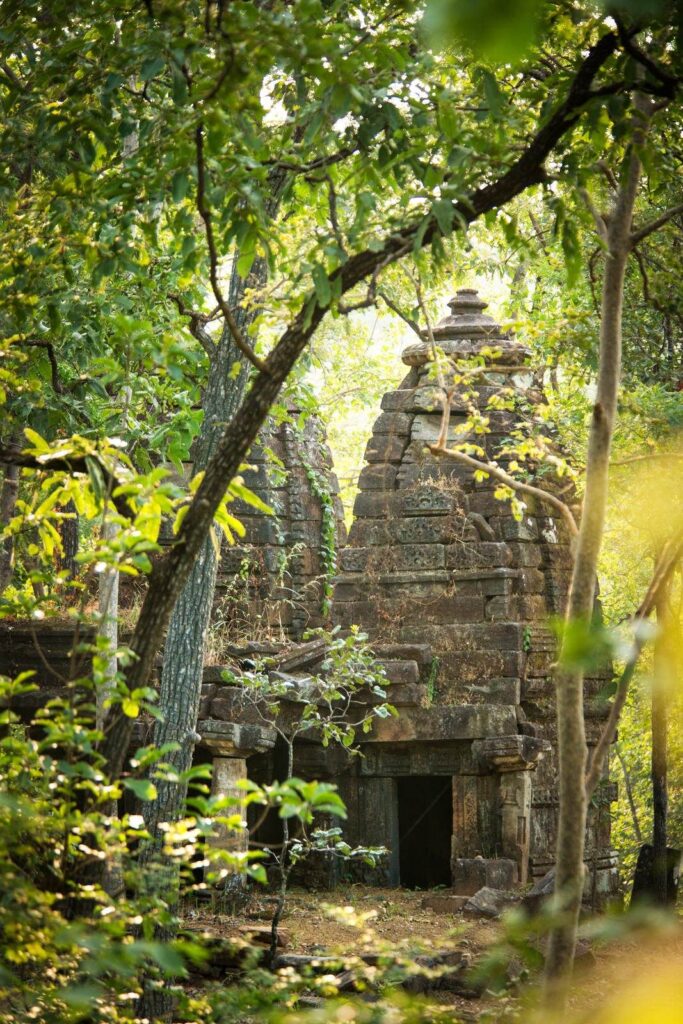
The yogi established a temple in the jungle near the village of Sharadaipur, and as he exhibited many mystic potencies, numerous people came to serve him. It was “predicted” in the concocted scriptures of the Atibaris that there would be a battle on the 14th of Caitra (March-April) 1871, and that Maha-Vishnu would then reveal His four-armed form. This news was spread in the villages, and the yogi sent out a circular announcing that Bhagavan Maha-Vishnu, who had descended as Bisakisena, would deliver India from the hands of the Europeans by killing them all.
He also began to exhibit various miracles to impress people. He would sit erect in front of a fire and lean into the flames for some time and then return to an erect position without injury. He could read people’s minds, instantly cure diseased persons and manifest fire from his head. To those who lacked knowledge of the various yogic practices by which siddhis are acquired, these events seemed extraordinary, even Godly. However, to a serious student of the doctrines of yoga, like the Thakur, such powers were simply an insignificant display of material power acquired by austerity, with no real spirituality.
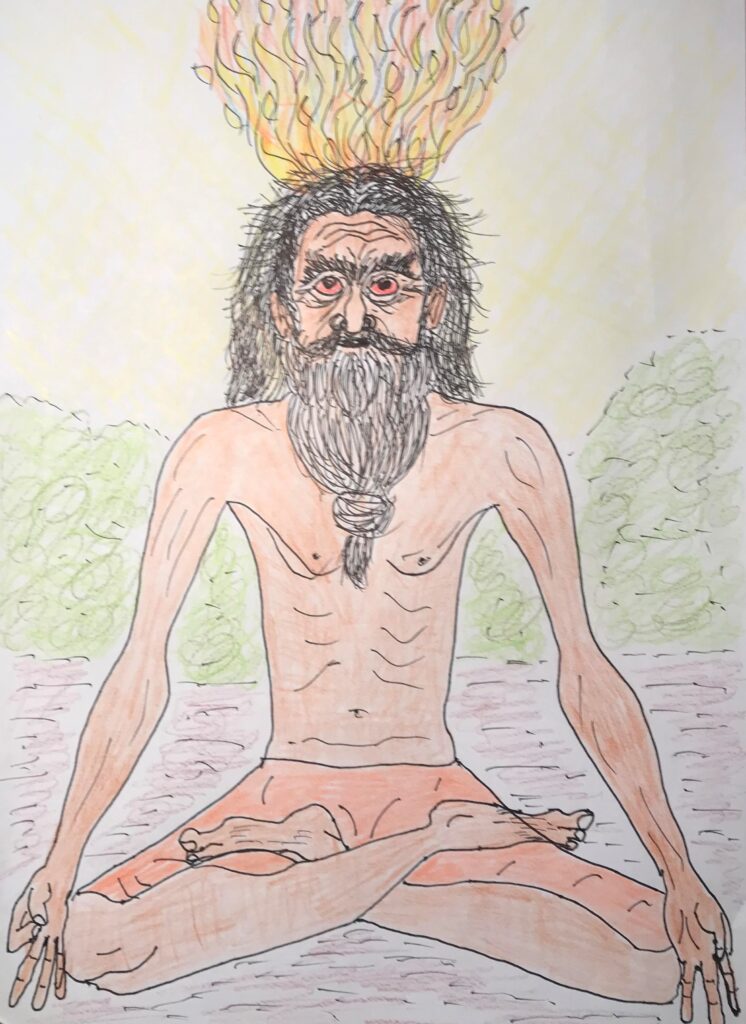
Even to this day in India, unscrupulous persons who perform severe penances acquire these magical powers simply to get a large following and exploit their simple-minded followers for material advantages. Their naïve followers often become convinced of the divinity of the rascals and worship them as God. Yet such persons are really no better than “confidence men” in one of the world’s oldest “con games” – tiny conditioned souls masquerading as God and convincing other foolish conditioned souls to worship them as such.
Two of the yogi’s associates posed as the guna avatars, Brahma and Shiva. Living in the jungle, not far from Bhuvaneswar, he established a temple, using funds that certain of the intimidated kings of Orissa had sent at his request. Some of the kings and villagers even sent women for his pleasure when he announced that he would hold a rasa dance in which he would exhibit his sole supremacy and power over women. When he actually had sexual relations with the wives and daughters of leading citizens of an Orissan town called Bringarpur, it created an outcry among the husbands, fathers and other leaders there, and they took their case to the government officials.
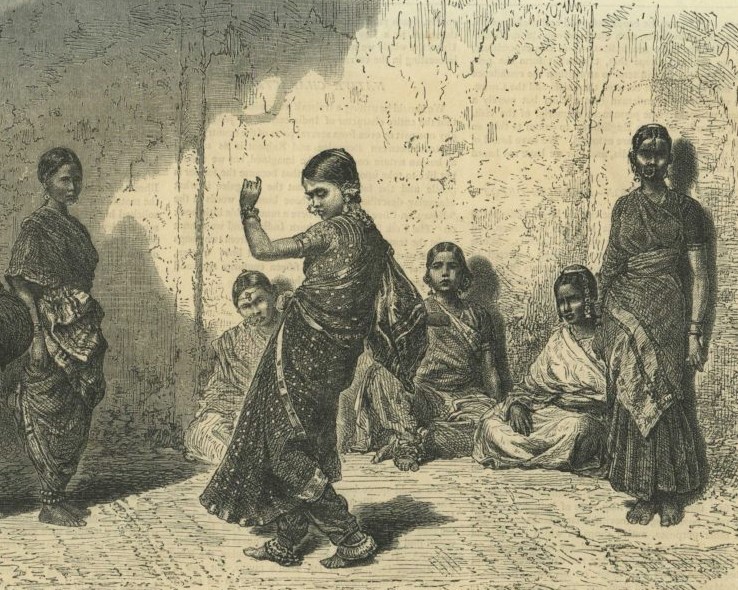
Mr. Ravenshaw, the English District Commissioner, was at that time in charge of the Orissan division of the National British-Indian Government. After hearing from the leaders of Bringarpur, he decided to entrust the case to Srila Bhaktivinoda Thakur for a thorough investigation. The case was very sensitive. Bisakisena had gathered a large following of sympathizers, and he was seen as a potential threat to the security of the region, possibly capable of fomenting a local revolution.
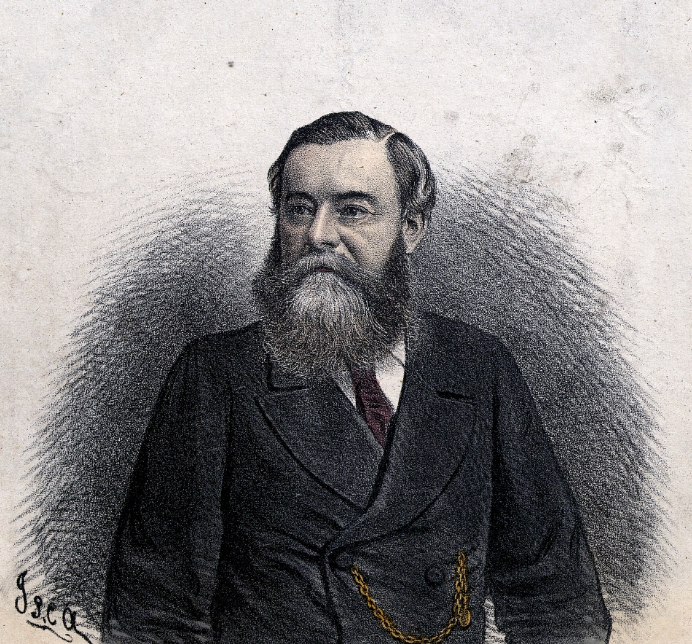
Thomas Edward Ravenshaw
The Thakur set out with the District Superintendent, the Chief of Police and a few constables. In the evening, just at sunset, the Thakur entered the jungle where the yogi was staying, near the village of Sharadaipur. He found many people sitting with the yogi. Many sick people had come to get cured by him and were glorifying him as an incarnation of God. Upon the arrival of the Thakur, the yogi rose from his throne and questioned him:
O babu, I know that you are a Bengali and a Magistrate. Why have you come here on this dark night?
Srila Bhaktivinoda Thakur replied, “I have come to see you.” Bisakisena then rejoined:
That being the case, please sit down and hear my teachings. I am Maha-Vishnu. Arising from the ocean of milk, I have come to this place, and very soon I will destroy all the Europeans, including the King of England. I have proclaimed this everywhere.
In his autobiography the Thakur says:
… I went at night to that jungle and spoke at length with Maha-Vishnu, and he revealed his vow to destroy the English Raj.
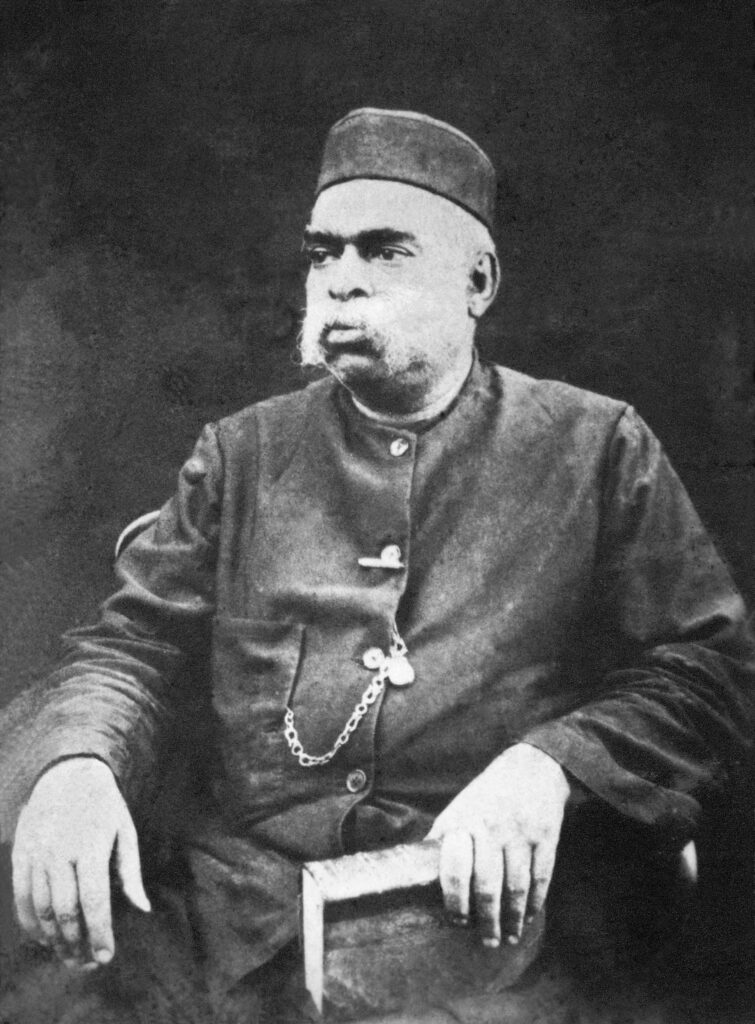
After saying this, Bisakisena gave the Thakur a piece of palm leaf that had the very thing that he had just said written on it in poetic form. Exhibiting his mystic powers, the yogi began to describe everything about Thakur Bhaktivinoda in detail, mentioning amongst other things his name and mission. He warned him not to interfere, and revealed that he knew full well about the men that the Thakur had brought with him, who were now hiding among the trees. The Thakur was not impressed, and he asked the yogi:
If you are Maha-Vishnu, then why are you staying in the jungle and not at Puri where Lord Jagannath resides?
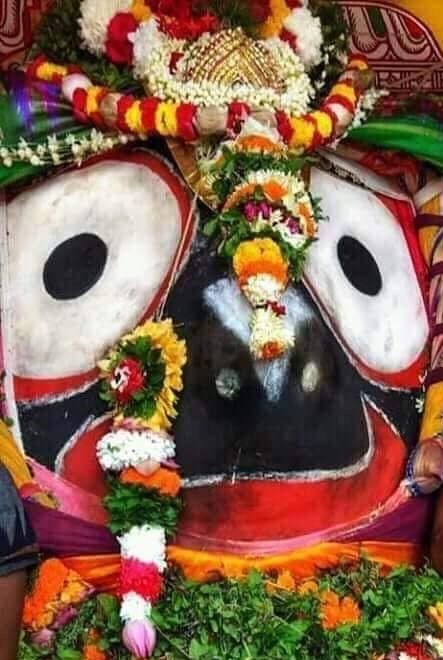
The yogi replied haughtily:
I am personally the Supreme Lord. There is no God at Puri. That so-called God, Jagannath is merely a big slab of wood. Sri Chaitanya was my beloved devotee, and I will again make India the kingdom of the Hindus. For this reason I am living in the jungle. I know that you are an excellent court judge and a good devotee as well. When the Hindu kingdom is again established, I will give you a very good position in the government. I will make you the governor of the entire state of Orissa.
Srila Bhaktivinoda Thakur became angered at the yogi’s offensive attitude towards Lord Jagannath and chastised the yogi. He gravely replied:
The tiny living entity can never become God. Ravana, Hiranyakashipu, Sisupala, Dantavakra (friend of Sisupala and formerly Hiranyaksa, brother of Hiranyakashipu) and many others who came under the influence of this arrogant mentality were all destroyed.
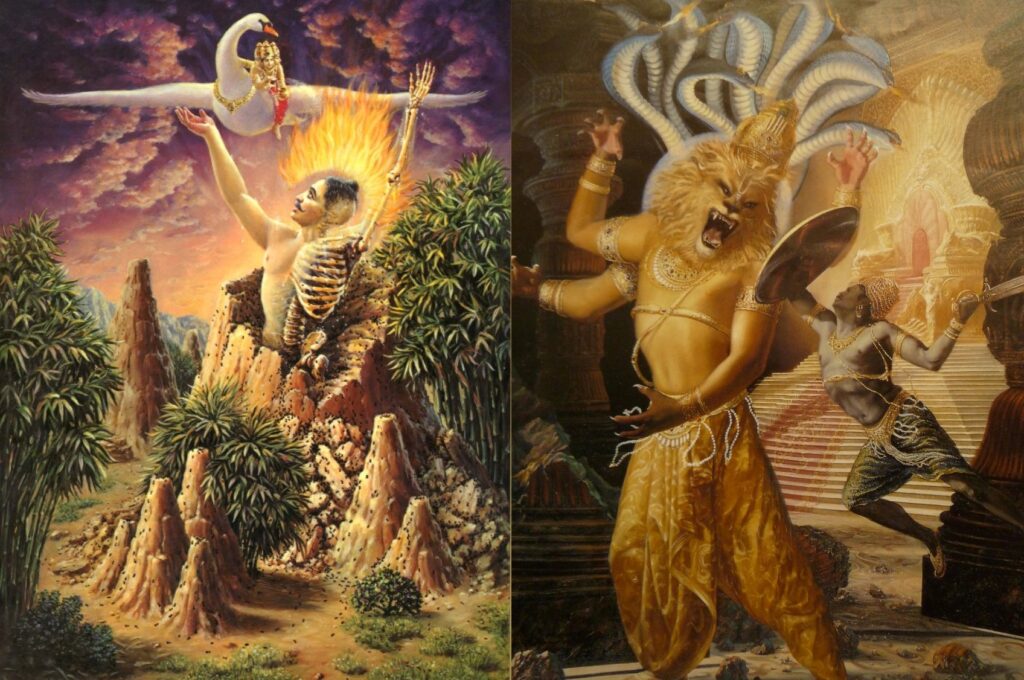
The yogi, in order to impress the Thakur with his power, then called before him many people with incurable diseases, and in a moment made them well. One person was suffering with a spear wound. The yogi brought him under his control and produced some ashes which he smeared on the wound. Immediately the wounded man was well and free of pain. The Thakur was not moved, correctly seeing the yogi as an offender to the Lord, using God-given powers for his own self-aggrandizement.
Leaving some spies to watch the yogi, the Thakur spent the night in a tent at Sharadaipur. The yogi had to be arrested, but first further investigation needed to be made. The next day he traveled to the villages in the region to gather reports from the people. In some villages he heard praise, but others were angry about the yogi’s affairs with married women and were anxious that this fever of attraction to the yogi might spread to the women of their own villages and result in scandal and humiliation.
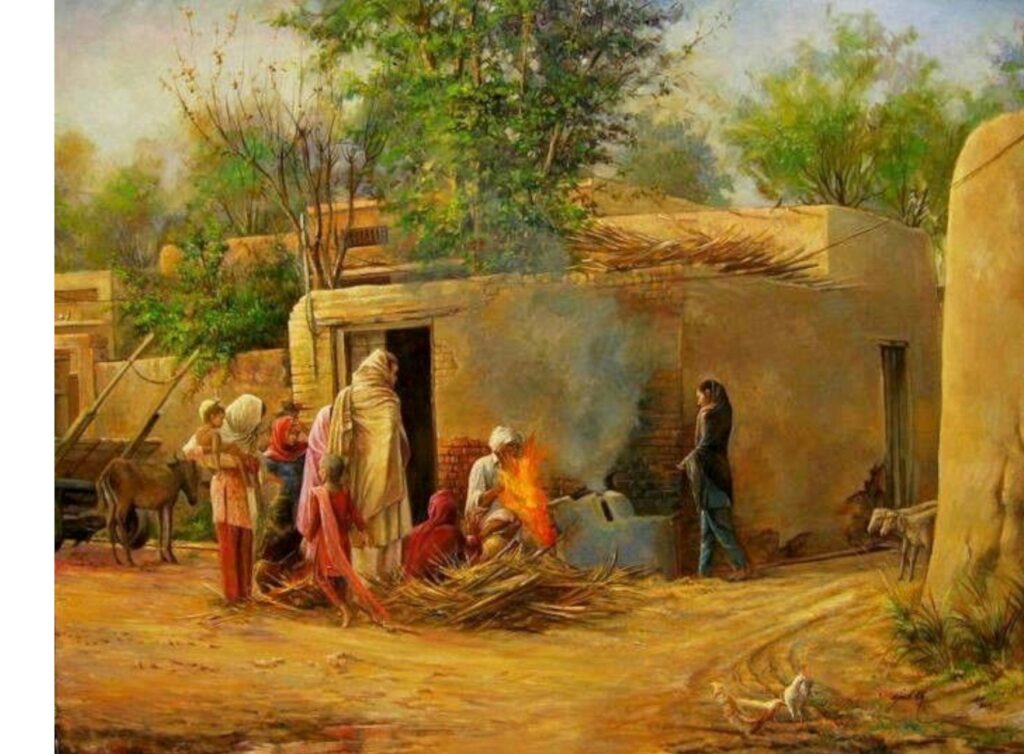
Thereafter, the Thakur gave the order to arrest the yogi, and seeing his men fearful, he personally led them, bringing with him two police inspectors, a police superintendent and over one-hundred armed policemen. They arrived in the early morning hours. A sacrificial fire was burning in front of Bisakisena and well over a thousand followers were present. Many were offering prayers to the yogi. The Thakur and the policemen appeared on the perimeter of the crowd. When the yogi’s followers saw the turbaned policemen, armed with rifles and bayonets, many of them began to flee. News was quickly spread to the villages that the Government had sent an army to arrest the avatar of God! Bisakisena sat observing all of this calmly.
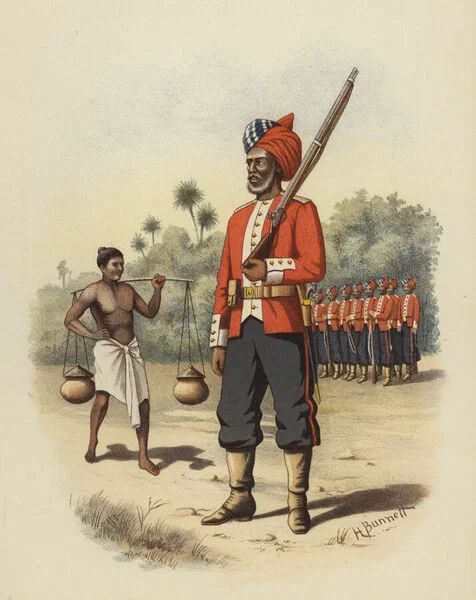
Srila Bhaktivinoda Thakur approached him. There was a short silence. “Babu, what is the meaning of all this?” asked the yogi with apparent serenity. The Thakur replied:
They have come to take you. It is the Governor’s orders that you should be brought to Puri.
The yogi replied harshly:
Who is this Governor? I am King, for I am the Supreme Godhead and master of all the universes. I bow down before no one. Let us see who is able to take me away from this place!
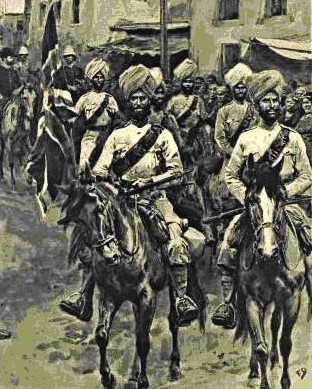
The Thakur replied sternly:
If you do not go peacefully, we will be obliged to take you away by force.
Becoming enraged, the yogi cried;
I order you to immediately leave this place! Let us see who has the power to take me!
Saying this, the yogi shook his head violently, whereupon hundreds and hundreds of fiery flames like burning snakes began to fly out of his matted locks. The yogi’s eyes then became bright red and sparks of fire shot out of them. Seeing this, the police force became terrified and fell back apace.
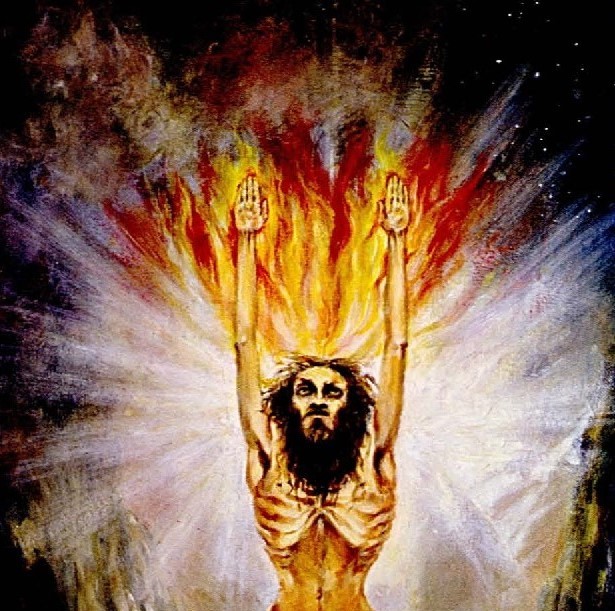
Srila Bhaktivinoda Thakur then declared:
Bisakisena! You may show us as much magic as you like, and we certainly will not forget it. However, you are an offender at the feet of the Supreme Lord. Although you are an insignificant living being, you are proclaiming yourself to be God, but actually you despise God. Furthermore, you are a rebel. You must go to Puri, where you will be judged.
The yogi shouted:
I will not go! My power remains, therefore – go away!
Thakur Bhaktivinoda ordered four police constables to bring a bullock cart from a nearby village. As they waited for the cart the Thakur preached to the irate yogi:
You must give up your deluded mentality and admit your imperfection. Your mystic powers are very insignificant in comparison to the opulences of the Supreme Godhead and the greatness of the Lord’s devotees. I request you to correctly understand this just once.
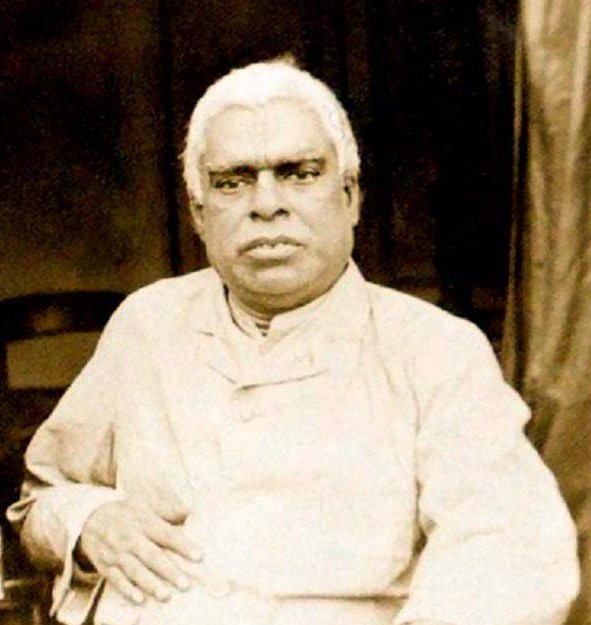
The yogi reacted like a trampled snake:
You obviously do not know who I am. If I, just once, ignite the fire of my anger, the three worlds will burn into ashes, but because I am very kind to the universe, I am not doing it.
Srila Bhaktivinoda Thakur began to laugh, saying:
Accha, let us now go to Puri. When we get there, you can display the fire of your anger.
By this time, the bullock cart had arrived. Seeing no way out of his predicament, the yogi ascended the cart, but before doing so he announced to the Thakur:
It is the word of the devotee that the Supreme Lord protects, therefore I am only going to Puri to protect your word that you would bring me there.
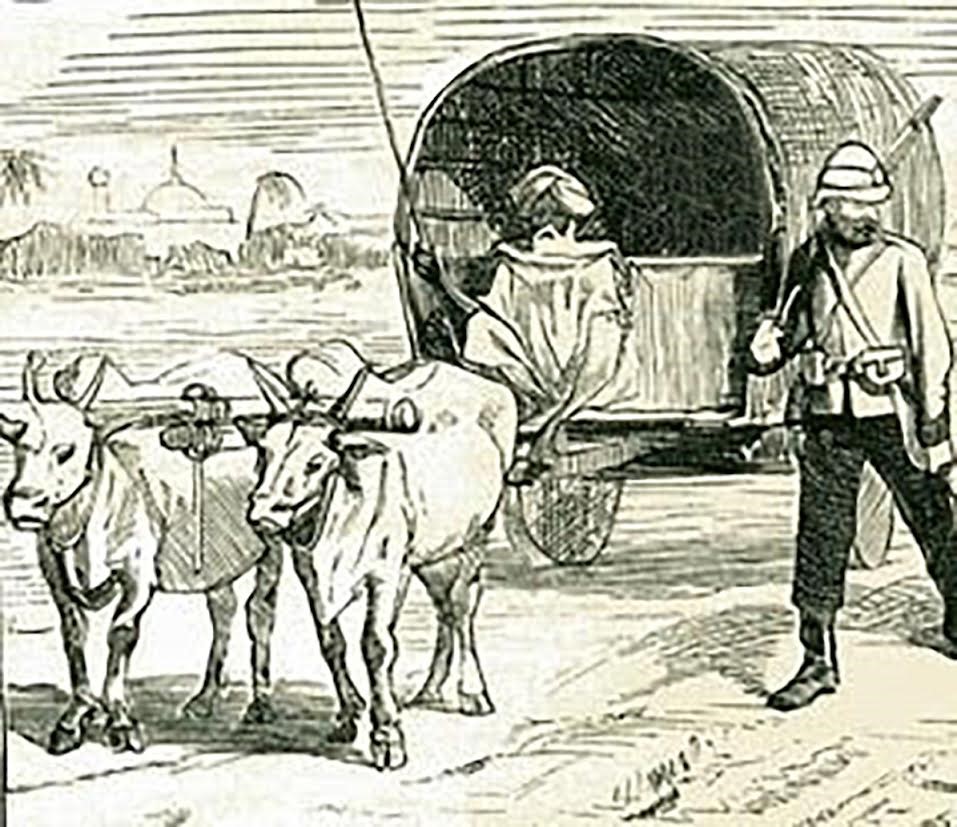
On the way to Puri, the Thakur began writing up his judgement of the case to date. As the Thakur wrote, the yogi began exhibiting his mystic powers from the back of the cart. The Thakur noted them but remained steadfast. Upon arriving in Puri the yogi was placed in solitary confinement until the trial. Srila Bhaktivinode Thakur put three dozen Moslem constables and seventy-two Cuttack policemen in charge of guarding his cell day and night. He then departed to arrest the false Brahma and Shiva, who later pleaded that they had been coerced into their respective roles by Bisakisena. They were later prosecuted.
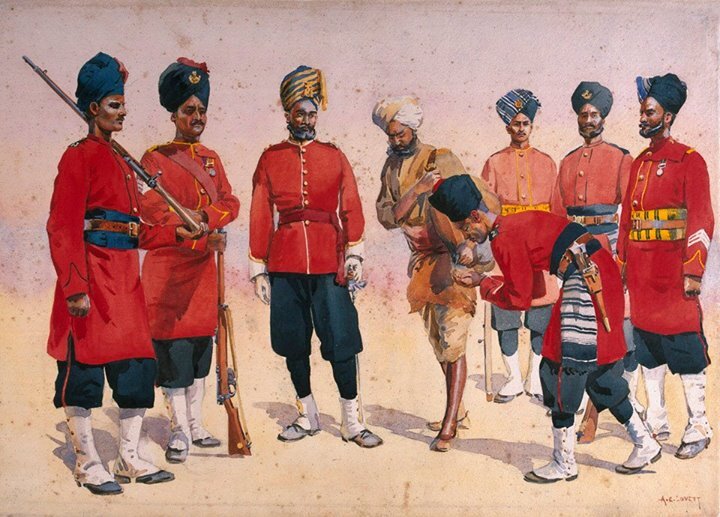
Bisakisena fasted from both food and water and did not sleep at all. Srila Bhaktivinoda Thakur repeatedly requested him to eat and gave him many valuable spiritual instructions, but Bisakisena would not hear him. During the pre-trial period many Orissan people took up a collection and hired a lawyer to defend Bisakisena in court.
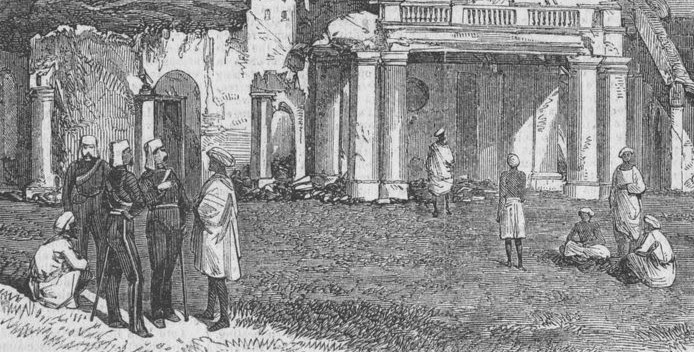
The trial lasted eighteen days. It was held in the district court at Puri. Almost one-thousand of the yogi’s followers and sympathizers gathered outside the courthouse during the trial, shouting their demands for the yogi’s release. On the fifth day of the trial, court was adjourned for the day. At the completion of the sixth day’s hearings, Bisakisena ominously threatened the Thakur:
Babu, you must immediately desist from prosecuting me or everything you have will be destroyed. Go to your home now and see what disaster is taking place there.
When he arrived at his home, he found his second daughter, seven-year-old Kadambini, afflicted with some deadly disease and high fever, repeatedly losing consciousness. Loud sounds of lamentation filled the house, but the Thakur did not fail in his determination, for he knew that the Lord would protect him from the insignificant powers of a yogi. The Thakur’s wife, Srimate Bhagavati Devi, became very anxious for the safety of their children, and she pleaded with her husband to let Bisakisena go before he destroyed their whole family.
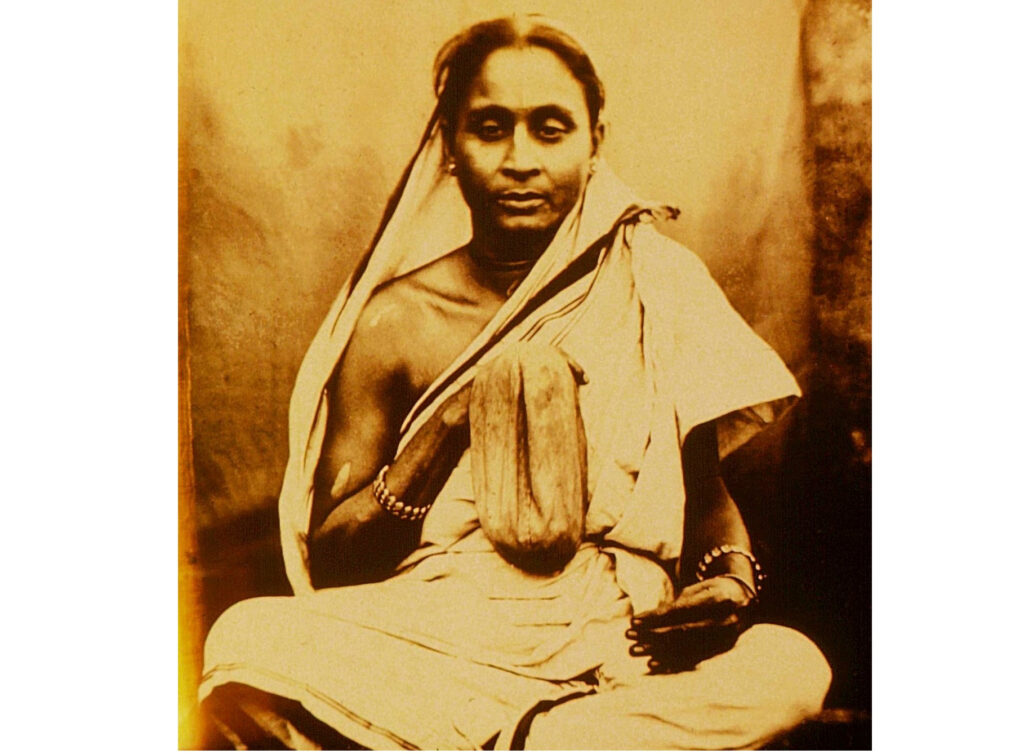
Srimate Bhagavati Devi
The Thakur replied:
Yes, let us all die, but this rascal must be punished!
Many doctors came to attend his daughter, and by eight o’clock in the morning she was well, and playing in the courtyard.
The Thakur recalls the period in his autobiography:
All over Puri there were disturbances. At that time the Puri school had a fire, and all of the people suspected him (Bisakisena). Also, at this time Kadur (a nickname for Kadambini) came down with fever. Bisakisena, by his practice of yoga, had by some means attained yogic powers, and I obtained a lot of evidence against him. For twenty-one days he did not eat or drink even a drop of water, but he did not show any weakness and gave unfailing cures to many people.
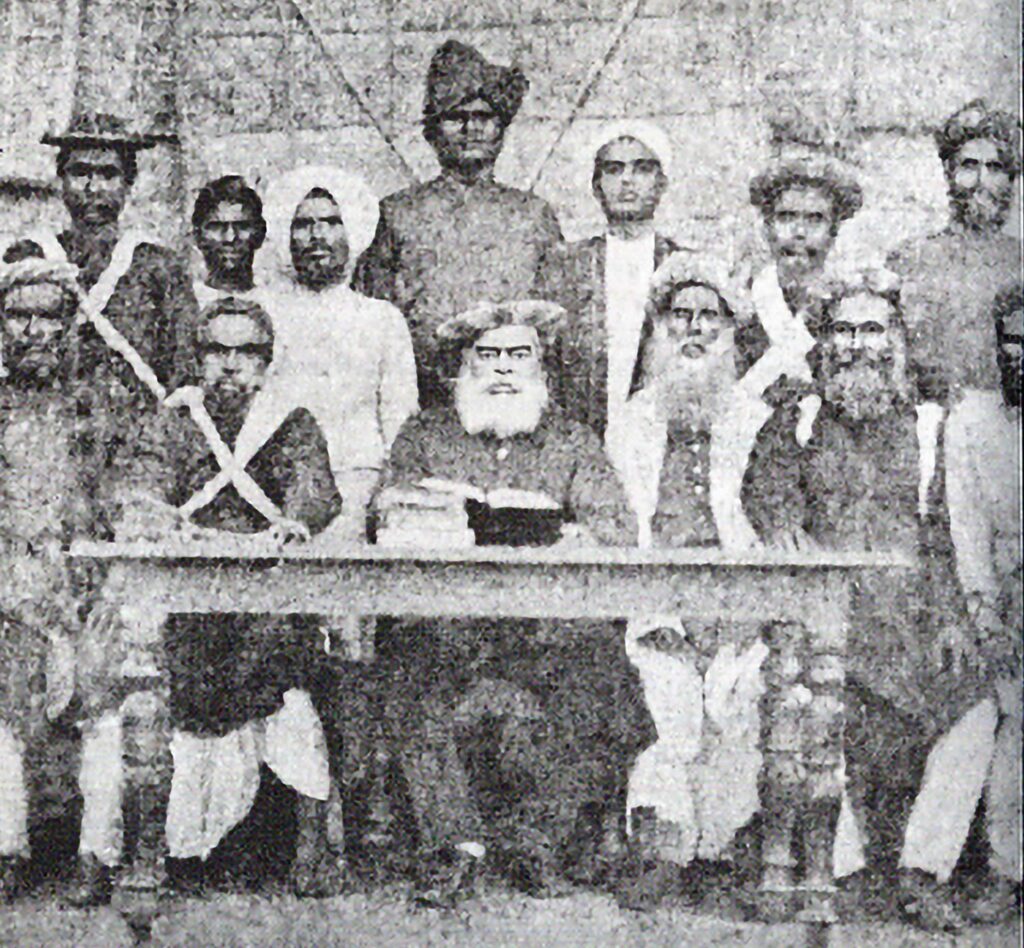
On the seventeenth day of the trial, when the court rose for recess, Bisakisena stood up and screamed violently at the Thakur:
Did you see what great calamity occurred at your house the other day? Still you are not coming to your senses! When will you be able to recognize me as the Supreme Lord? The final day of my judgment will be your death! What is the punishment for one who disrespects an avatar? How death sits on the seat of judgement and gives out his commands, I will see!
When Thakur Bhaktivinoda returned home in the late afternoon of that day, he took off his court clothes, and all of a sudden, he felt a sharp pain on the right side of his chest. As the night went on, the pain increased. The Thakur was unshaken in his determination, but it was unclear how he would be able to enter the court in such a condition to give his final judgment. In the morning the severe pain persisted. Finally, by about 10 A.M. he felt a slight subsiding of the pain, and he was ready to write the judgment. He was unable to walk and had to be carried to his palanquin.
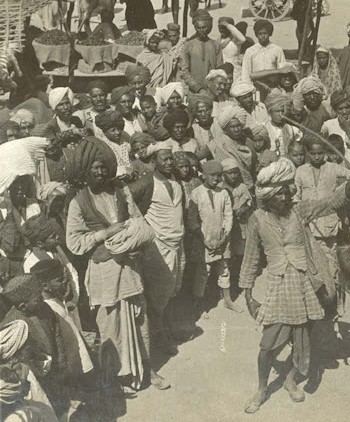
On that final day a thousand of the yogi’s followers again gathered in front of the courthouse and created a terrific din. Inside, the trial ensued. The Thakur’s decision was announced:
Bisakisena is found guilty of political conspiracy against the National British-Indian Government, as well as the State Government of Orissa and is therefore sentenced to eighteen months of strict imprisonment and hard labour.
When the huge crowd outside received the news of Bisakisena’s sentence, they made a tremendous uproar and began to cry in unison, “Injustice! Injustice!”
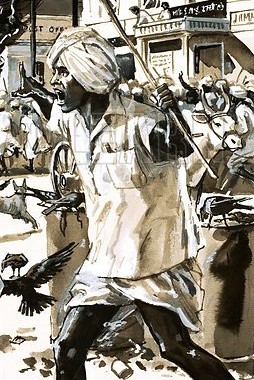
Bisakisena was being led away from the court, when suddenly the District Medical Officer, Doctor Walters, jumped on the rascal from behind and cut off his long hair with a large pair of scissors. The English officer had come to know from his studies of yoga that yogis often conserve their powers in their hair. As soon as the matted locks of Bisakisena were cut, he fell to the floor devoid of all power and unable to walk. The pain in the body of the Thakur vanished, and the yogi was removed from the courtroom on a stretcher. When his followers saw that “God” had been overcome by having his hair removed, most of them deserted him. Srila Thakur Bhaktivinoda recalls in his biography:
When his hair was cut, his followers said that he was a cheater and left him.
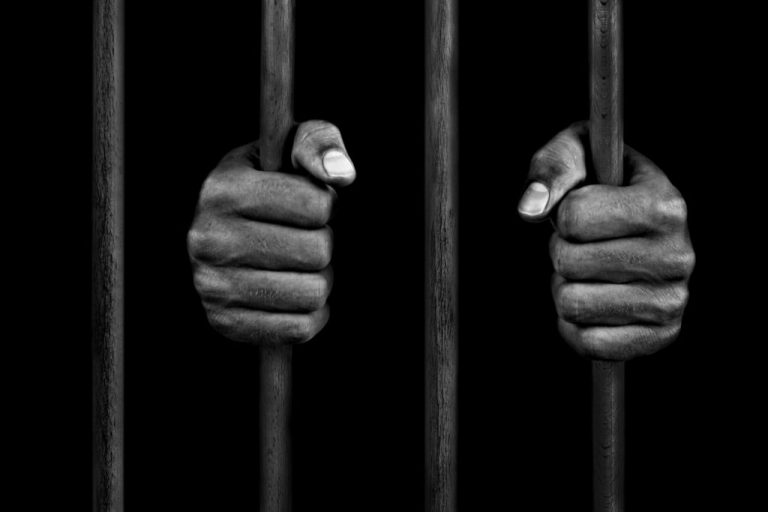
The Thakur walked home peacefully. Bisakisena was held in the Puri jail for three months and then transferred to the central jail in Medinipur. As a result of his offences against a pure devotee of Krishna, Bisakisena went insane. In 1873, while still in prison, he took poison and died.
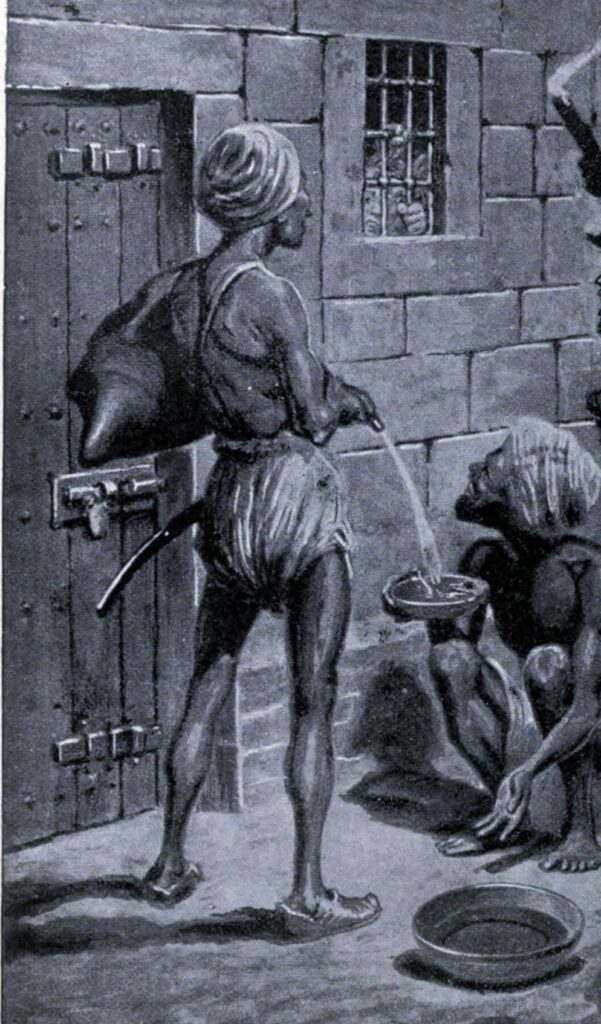
After the rise and fall of Bisakisena, there were other so-called incarnations. In Yajpur, a “Brahma” took over Bisakisena’s former group and was similarly punished, and in Khandagiri, a “Balarama” made his attempt but was also quickly thwarted. Just as Durvasa Muni had attempted to punish the pure devotee Ambarisa Maharaja but was himself punished, a similar attempt was made on Thakur Bhaktivinoda, but by the grace of the Lord he was fully protected.
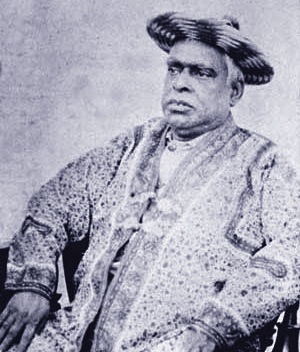
[Excerpts from “The Seventh Goswami” by Rupa Vilas Das and from the Autobiography of Bhaktivinoda Thakur, biographical notes of Lalita Prasad Thakur and other biographers. Additional information from lectures of Srila Bhaktivedanta Swami Prabhupad]
Bhaktivinoda Thakur and the Ghostly Priest of Kulina-grama
There is a story from the life of Srila Bhaktivinoda Thakur that illustrates the importance of receiving the Holy Names of Krishna from the bona fide self-realized devotee of the Lord.
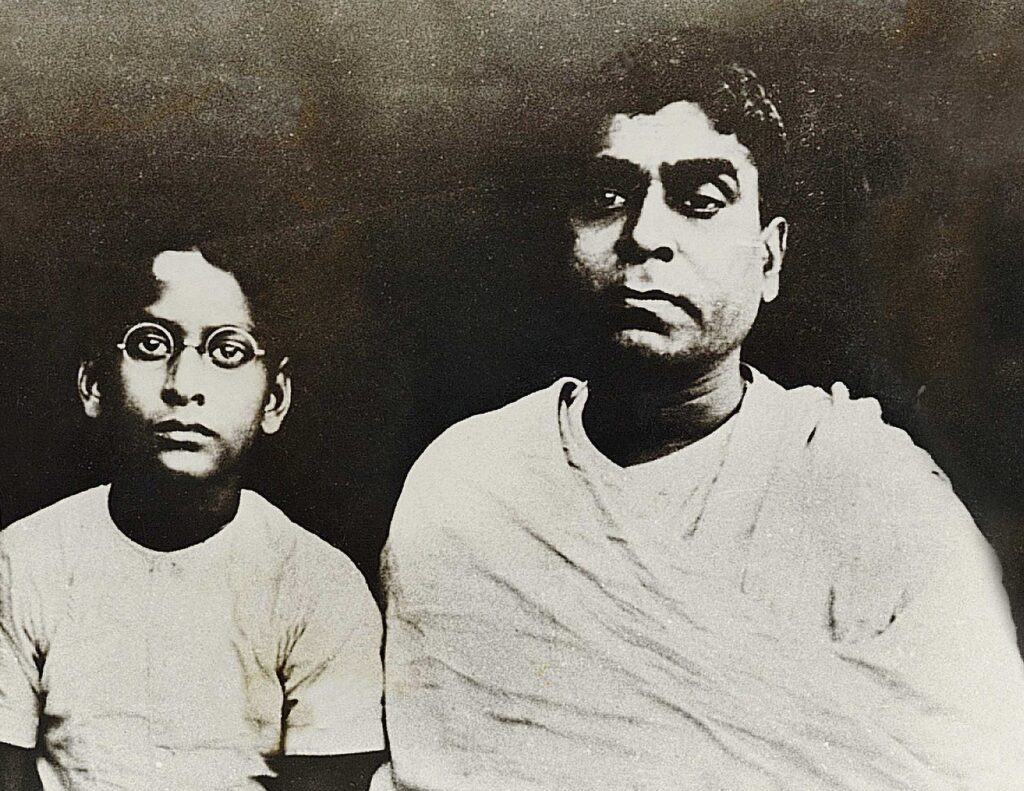
When Srila Bhaktisiddhanta Saraswati Thakura was a young boy, both he and his father, Bhaktivinoda Thakura, went to visit the holy place of Kulina-grama, which is located in the Hooghly district in Bengal, not far from Calcutta. The village of Kulina-grama is described in Caitanya-caritamrta:
… the residents of Kulina-grama are very dear to Lord Caitanya because even the swineherds there chant the holy names of Krishna.
The village is also responsible for supplying the silken ropes which are used to bring Lord Jagannath to His Ratha cart at the famous annual festival in Puri. The great devotee Haridas Thakur and many other famous Vaisnavas used to live in Kulina-grama. It was the home of four generations of devotees.
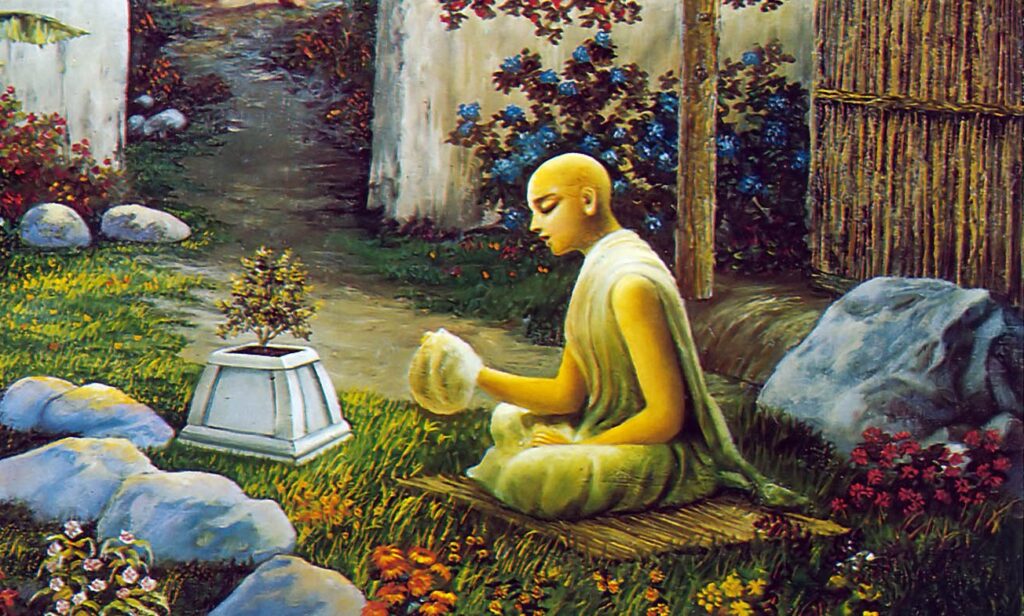
Haridas Thakur
Srila Bhaktivinoda Thakur and the young Bhaktisiddhanta Sarasvati went to visit that ancient holy place, and just on the outskirts of Kulina-grama, as they were entering the village, they passed by an old temple. Suddenly, a man came out of the temple and humbly asked them, “Please stay the night here. In the morning you may enter the village and take darsana of all the places there.”
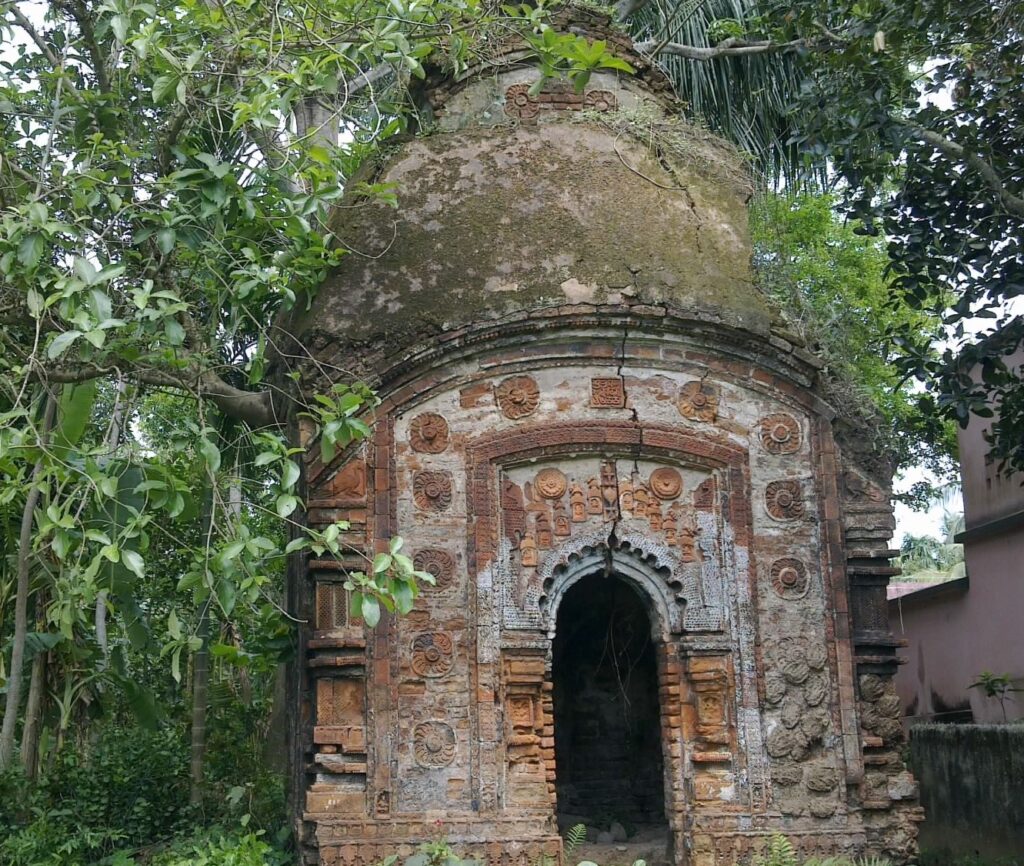
Bhaktivinoda Thakur and Bhaktisiddhanta Saraswati, who at that time was a young boy, stayed the night in that temple house. Just after nightfall, as they were resting, Bhaktivinoda Thakur experienced something unusual. He found that brickbats [pieces of brick or rock] were being thrown about from different directions. He thought, “How is this happening and why? Who would throw big brickbats like this?” Then he had some apprehension that there might be ghosts living there, creating disturbances. He began loudly chanting the Hare Krishna maha-mantra. After some time, the disturbance disappeared, and Bhaktivinoda Thakur and Srila Bhaktisiddhanta passed the rest of the night there peacefully.
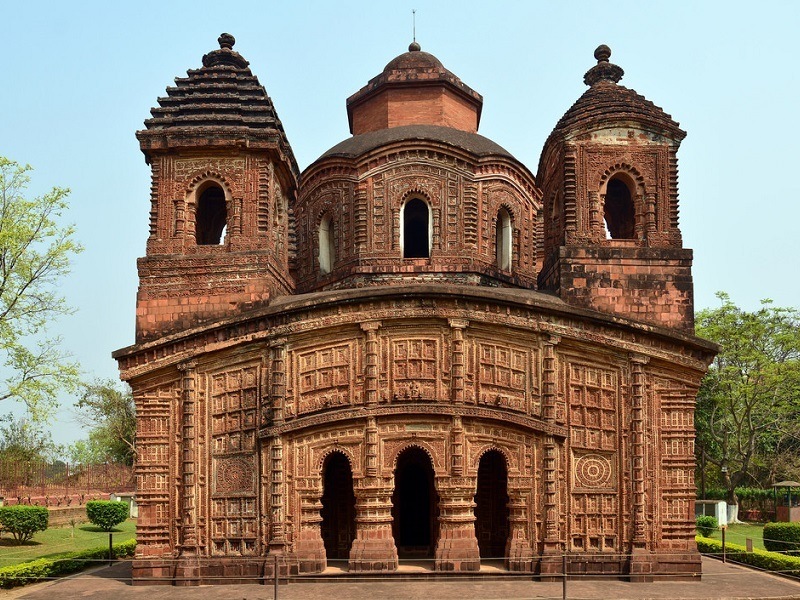
In the morning, they entered the village and began visiting different holy places. After some time, one of the local gentlemen noticed them and said, “You entered our village early this morning. Where do you come from? And where did you spend the night?” Bhaktivinoda Thakur explained:
We stayed in that temple just outside the village there.
One of them said, “Oh! How could you stay there? So many ghosts live there and throw stones and bricks at anyone who passes by that place at night. How could you stay there?” Then Bhaktivinoda Thakur said:
Yes, you are right. But when I found such a disturbance there, I began to loudly chant the Hare Krishna maha-mantra, and subsequently the problem disappeared.
The men of the village then asked Bhaktivinoda, “Who are you, and where are you coming from?” Then they came to know that he was Bhaktivinoda Thakur. They had already heard of him, and some of them had read his books. They welcomed the two of them, and showed them all the holy places they had not yet seen.
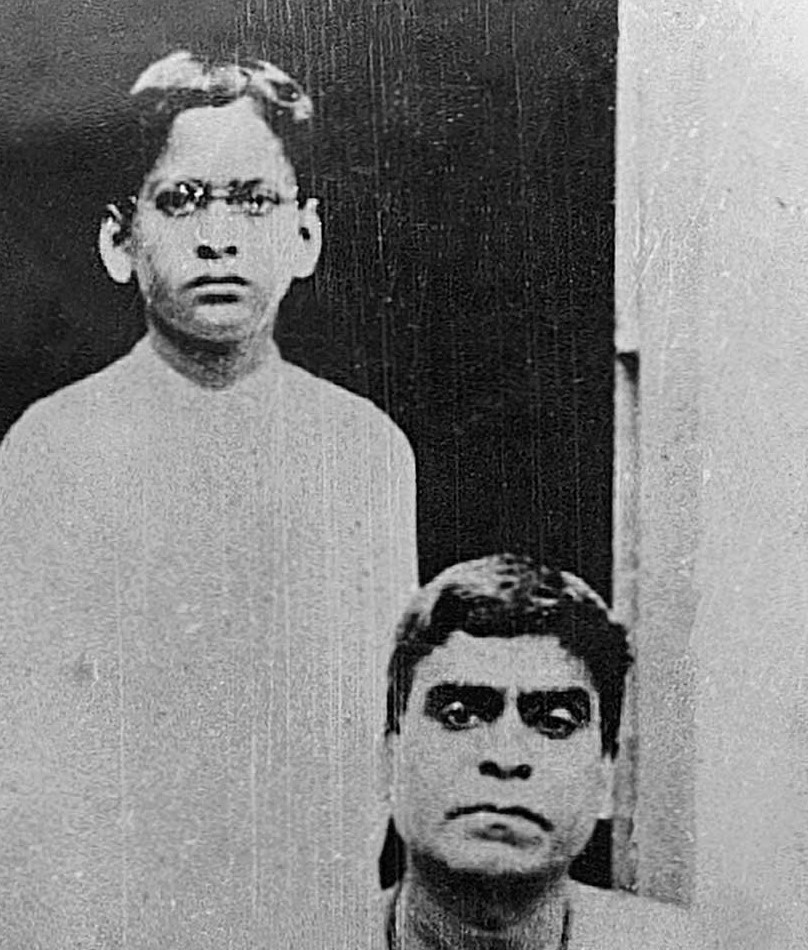
At one point, they said to Bhaktivinoda Thakur:
The gentleman who was formerly the priest of that temple was transformed into a ghost after his departure. Since that time, we have regularly seen the disturbances caused by that ghost. Why did he become a ghost? As the priest of that temple, he used to regularly chant the holy name of Krishna. We are witness to that fact; we have all heard him. Why was he turned into a ghost? We cannot understand this. Please explain.
Bhaktivinoda Thakur told them:
The priest must have only repeated the syllables of the name, the nama-aksara. What he was producing was only a mayik sound, a physical, lip-deep sound. It did not have the spiritual essence; the life of the name was absent when he was chanting. It was nama-aparadha, offensive chanting.
Bhaktivinoda asked them:
What was his character?
They said:
He was not a good man. He committed many sinful acts. That we know. But we can’t deny the fact that he used to chant the name of the Lord almost always. How could he become a ghost?
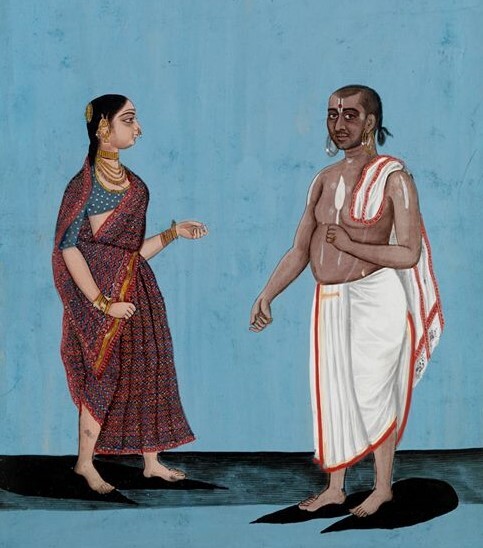
Bhaktivinoda Thakura explained that the physical sound of the name is not the name proper. The priest had been living sinfully and committing offenses to the holy name (nama-aparadha), and as a result became a ghost. They asked:
Then how can he be released from that wretched condition?
Bhaktivinoda said:
If he meets a bona fide sadhu who has a genuine connection with Krishna, and he hears the real name, or the proper explanation of Bhagavad-gita or Srimad-Bhagavatam from his lips, then he may be released from his ghostly condition. It is mentioned in the scriptures that this is the only way to become free from the entanglement of material nature.
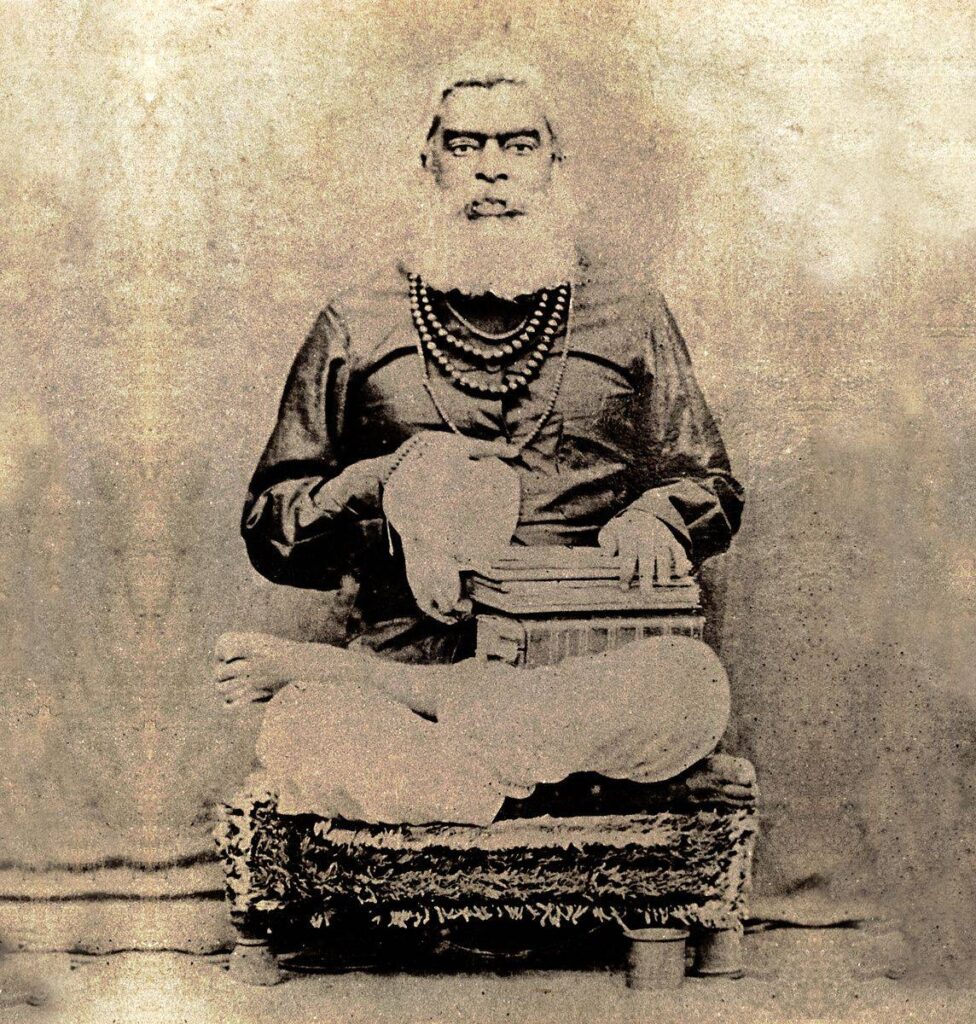
After this discussion, Bhaktivinoda Thakur and Bhaktisiddhanta Sarasvati left Kulina-grama. From that day on, all the troubles caused by the ghost at the temple in Kulina-grama ceased. The villagers were astonished. One of them said:
That priest who had become a ghost must have been released from his ghostly condition after hearing the holy name chanted by Bhaktivinoda Thakur. When the trouble began, Bhaktivinoda loudly chanted the name, and gradually, by hearing the holy name of Krishna from his holy lips, that suppressed soul has been liberated from his condition as a ghost.
After that, many people journeyed to see Bhaktivinoda Thakur. They would tell him:
We are confident that you are a great Vaisnava – after hearing the holy name of Krishna from your lips, a ghost has been released.
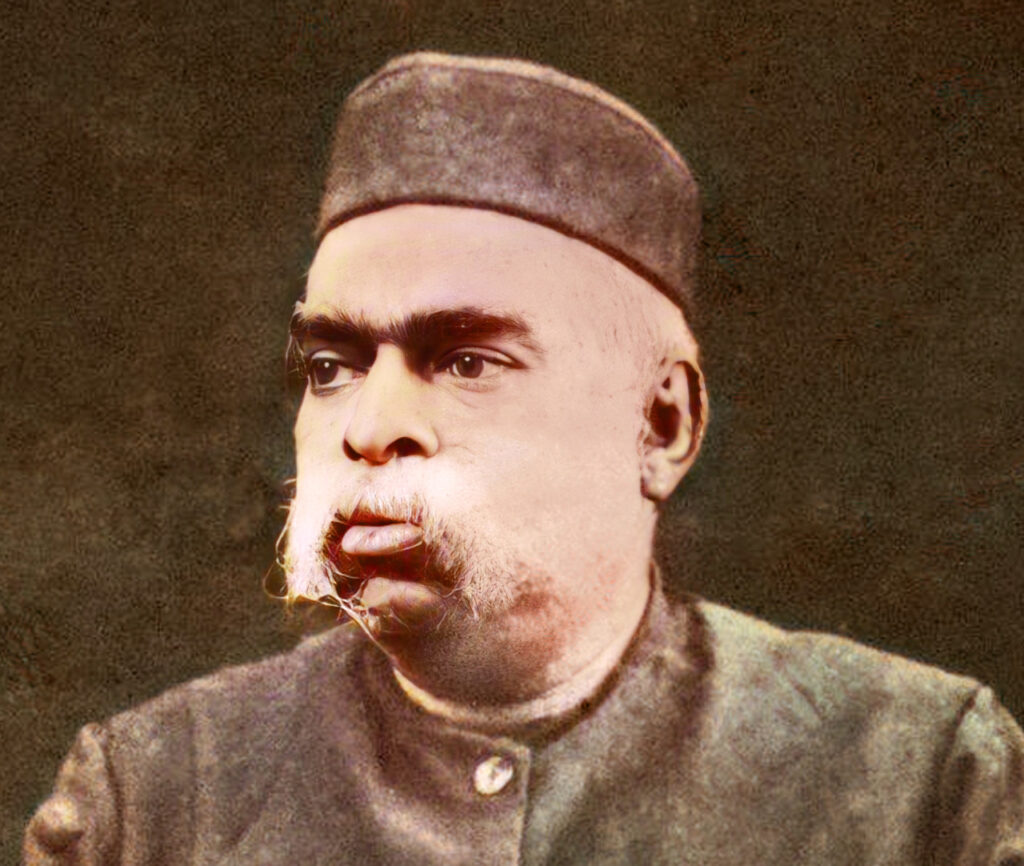
[Excerpts from “The Seventh Goswami” by Rupa Vilas Das and from the Autobiography of Bhaktivinoda Thakur]


2 Comments
Wonderful!
That’s amazing!